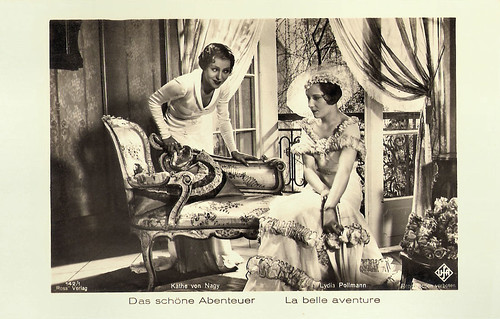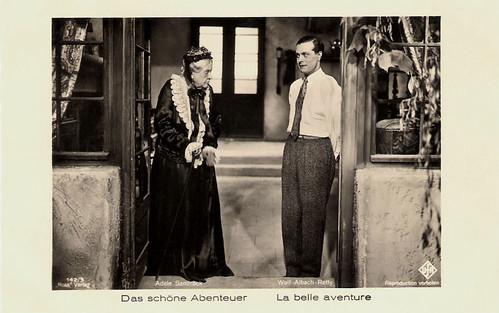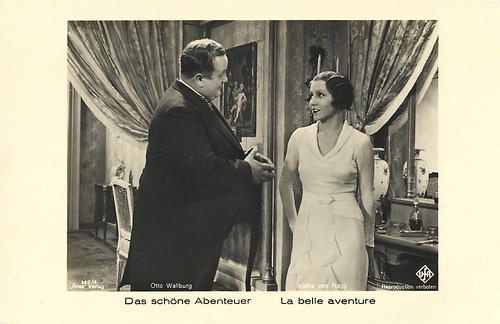
German postcard by Ross Verlag, no. 142/1. Photo: Ufa. Käthe von Nagy and Lydia Pollmann in Das schöne Abenteuer/The Beautiful Adventure (Reinhold Schünzel, 1932).

German postcard by Ross Verlag, no. 142/2. Photo: Günther Pilz / Ufa. Käthe von Nagy and Wolf Albach-Retty in Das schöne Abenteuer/The Beautiful Adventure (Reinhold Schünzel, 1932).

German postcard by Ross Verlag, no. 142/3. Photo: Ufa. Adele Sandrock and Wolf Albach-Retty in Das schöne Abenteuer/The Beautiful Adventure (Reinhold Schünzel, 1932).
The turmoil continues unabated
The story of Das schöne Abenteuer/The Beautiful Adventure (1932) is based on the French stage play 'La belle aventure' by Gaston Arman de Caillavet, Robert de Flers and Etienne Rey. Director Reinhold Schünzel and the future producer Emeric Pressburger wrote the screenplay. Helene de Trevillac (Käthe von Nagy) is an orphan who grew up in the house of the wealthy Countess d′Eguzon (Ida Wüst). Now she has matured into an attractive young lady with whom the count's son André (Wolf Albach-Retty) has fallen in love. This, in turn, does not suit the old countess at all and she pulls strings. Countess d′Eguzon manages to get André transferred to faraway Vienna as part of the diplomatic service.
Out of sight, out of mind, believes the scheming old woman and immediately goes one better by "organising" a suitable husband for her ward Helene: The aristocratic but unattractive Valentin le Barroyer (Otto Wallburg). To prevent contact with André, the countess secretly intercepts the letters he sends to Helene at home, so that Helene is forced to believe that André has forgotten her in the meantime.
So it is with a heavy heart that Helene agrees to marry Le Barroyer after all. At the last moment, however, the count's intrigue fails because, contrary to expectations, the love-struck André, still pining for his Helene, returns home on the day of the scheduled marriage between Helene and the unsympathetic fat man Valentin. The reunion of the two lovers is overwhelming, and both now realise that André's mother has betrayed them.
André and Helene run away together, leaving Le Barroyer alone in front of the altar. The destination of their escape in André's car is the house of Helene's grandmother, Mrs de Trevillac (Adele Sandrock). As the old lady has strict moral standards and runs a tight ship at home, Helene's grandmother is led to believe that André is Helene's newlywed husband. She even provides the two of them with a shared bedroom with a large marital bed so that the supposed couple can have children early on. To be on the safe side, the superstitious old woman places sprigs of rosemary in front of the bedroom door, a kind of fertility symbol.
The following day, Valentin suddenly appears on Mrs de Trevillac's doorstep and angrily demands the return of his estranged almost-wife. André is forced to meekly admit that he is not actually married to Helene. When his mother, Countess d′Eguzon, turns up, the turmoil continues unabated. André finally puts his money where his mouth is and declares to everyone that he and Helene are meant to be together and that they both want to get married soon. And it's only natural that they should because the early wedding night has led to Helene expecting twins thanks to the sprigs of rosemary.

French postcard by P.C., Paris, no. 76. Photo: Ufa. Käthe von Nagy sings 'Partons ensemble' in La belle aventure/Beautiful Adventure (Roger Le Bon, Reinhold Schünzel, 1932), the French language version of Das schöne Abenteuer (Reinhold Schünzel, 1932).

German postcard by Ross Verlag, no. 142/4. Photo: Ufa. Käthe von Nagy and Otto Wallburg in Das schöne Abenteuer/Beautiful Adventure (Reinhold Schünzel, 1932).

Dutch quartet play card, no. IX, 2. Photo: Ufa. Otto Wallburg and Adele Sandrock in Das schöne Abenteuer/The Beautiful Adventure (Reinhold Schünzel, 1932).
A sparkling wit with many small maliciousnesses
Reinhold Schünzel is one of the most underrated directors of German cinema. He was equally successful as an actor as well as a director, writer and producer. During the early sound film years, he directed a wonderful series of comedies, mainly for the Ufa, with an ironic attitude and musical verve. Stars of these comedies were Renate Müller or Käthe von Nagy and examples are Ronny (1931), Das schöne Abenteuer/The Beautiful Adventure (1932), the original drag comedy Viktor und Viktoria/Viktor and Viktoria (1933), the social satire Die englische Heirat/The English Wedding (1934) and Die Töchter Ihrer Excellenz/Her Excellency's daughters (1934).
In 1935 he shot Amphytrion with Willy Fritsch. I.S. Mowis at IMDb: "Schünzel's satirical, mythologically-themed musical farce Amphitryon (1935), in particular, had all the hallmarks of the ironic, feather-light and slightly risqué 'Lubitsch touch'. It also boasted above-average production values." Amphitryon was Ufa's number one box office hit of the year, but the Nazi government interfered in his films and as a Half-Jew, Schünzel depended on a work permit for each further film. He left the country after finishing Land der Liebe/Land of Love (1937) and before the film was released, he emigrated to the USA where he directed four films.
Reinhold Schünzel shot Das schöne Abenteuer/The Beautiful Adventure (1932) in the Ufa studios in Neubabelsberg from the end of April to the end of May 1932. The film premiered in Berlin's Gloria-Palast on 18 August 1932. Günther Stapenhorst was the production manager, Werner Schlichting designed the film sets. Erich von Neusser was the director of photography. Hermann Fritzsching was responsible for the sound. Fritz Rotter wrote the lyrics for Ralph Erwin's musical composition and Hans-Otto Borgmann was the musical director.
Schünzel also made a French-language version of this film in April 1932 under the title La belle aventure. Käthe von Nagy was the only German-speaking actress to reprise her role in this film. Daniel Lecourtois played the role of Albach-Retty. Roger Le Bon was Schünzel's French-speaking co-director. In 1959 assistant director Kurt Hoffmann would direct a remake, Das schöne Abenteuer, with Liselotte Pulver and Robert Graf.
The Österreichische Film-Zeitung (27 August 1932): "... a film that captivates more through its outstanding acting and superior directing than through the originality of its subject matter. (...) Käthe von Nagy plays the role of Helene naturally, finely and with nuance, Wolf Albach-Retty is a winning André." Oskar Kalbus' Vom Werden deutscher Filmkunst (1935): "Schünzel has created a film from which a rare harmony radiates, a pleasant cheerfulness, a sparkling wit with many small maliciousnesses, but no one is harmed."

German postcard by Ross Verlag, no. 142/5. Photo: Ufa. Wolf Albach-Retty and Käthe von Nagy in Das schöne Abenteuer/The Beautiful Adventure (Reinhold Schünzel, 1932).

German postcard by Ross Verlag, no. 142/6. Photo: Ufa. Käthe von Nagy and Wolf Albach Retty in Das schöne Abenteuer/The Beautiful Adventure (Reinhold Schünzel, 1932).
Sources: Filmportal (German), Wikipedia (English and German) and IMDb.
No comments:
Post a Comment